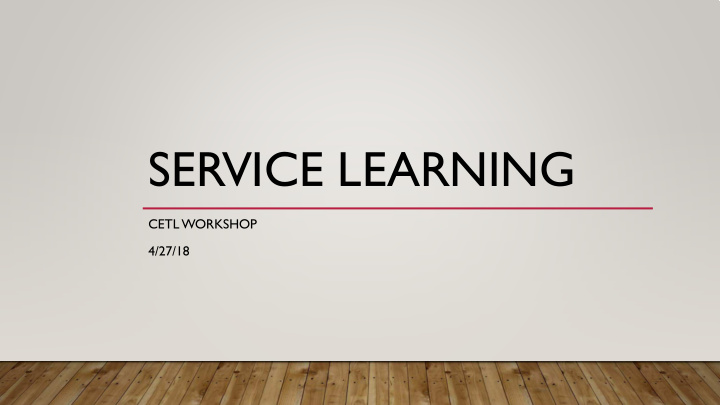



SERVICE LEARNING CETL WORKSHOP 4/27/18
GOALS • Consistent with UI’s Strategic Plan goals of outreach that transforms learning , inspires innovation and culture, and improves lives within and across a diverse local- to-global community, this session explores strategies for creating impactful and sustainable civic engagement opportunities with academic merit and service learning initiatives that emphasize and document significant learning , all with an eye towards our local, regional, state, national, and international presence . • What makes CE/SL a high impact practice?
THE DEFINITION…UNPACKED Civic/Community Engagement and Service Learning describe collaborations between institutions of higher education and their larger communities (local, regional/state, national, global) for the mutually beneficial exchange of knowledge and resources in a context of partnership and reciprocity . New England Resource Center for Higher Education (NERCHE) The Emphasis is on: • Partnership, not service • Community voice, not university expertise • Reciprocity, not one-way
THE PURPOSE • Enrich scholarship, research, and creative activity • Enhance curriculum, teaching and learning • Prepare educated, engaged citizens • Strengthen democratic values and civic responsibility • Address critical societal issues • Contribute to the public good
THE VALUE • Supports • Faculty (Retention, T enure, and Promotion) • Student (Retention and Learning) • Self-Interest • External Constituents • Internal Opportunities • Modeling Citizenship and Responsibility Harkavy, 2004
SIGMON’S 1979, ‘94 AND FURCO TYPOLOGY SERVICE-Learning Service is Primary, learning is secondary. Example: Co-Curricular, Centers for Volunteerism Service-LEARNING Learning goals are primary, service obligation is secondary. Example: Project-Based Learning Service Learning Service and learning goals both matter but are separate. Example: Academic CE or SL and Student service/CE SERVICE-LEARNING Service and Learning Goals have equal weight and enhance one another. Example: integrate services http://www.wou.edu/~girodm/670/service_learning.pdf Consider the sliding scale from service to learning
DISTINCTIONS Service Learning Fully integrated learning experiences Community service Field education Activities that primarily benefit recipients Complimentary but not integrated learning Students somewhat directly learn about how service enhances lives experiences and their own values Internships Volunteerism Participation in an applied Service recipient focused, driven environment. by volition. Learning is mostly serendipitous and unintentional Complimentary, not integrated
MOVEMENTS FROM TO • Teaching of content • Teaching content through active citizenship • Research of discovery • Engaged scholarship • Required service • Building sustainable partnerships
HOW? What are the opportunities and challenges… • Locally • Regionally • Globally How do you get it into your classes? Evidence of learning?
DEAL DIMENSIONS • The DEAL Model [see handout for the general model and p. 7 for models tweaked to address civic engagement and intercultural communication] • D escribe E xamine A rticulate L earning • Example: • Based on your service learning experience(s): • D escribe, E xamine, and A rticulate your L earning • Focus on cognitive and metacognitive processes and development • CRITICAL reflection
INTER- AND CROSS CULTURAL PROFICIENCY
AWARENESS • Awareness of implicit bias: https://ctl.yale.edu/ImplicitBiasAwareness • Tolerance Tests and Progress • Wicked problems • https://csl.iupui.edu/workshops-events/conferences/academy/index.html • Bringle • Hatcher • Ash and Clayton
Recommend
More recommend